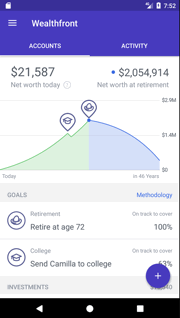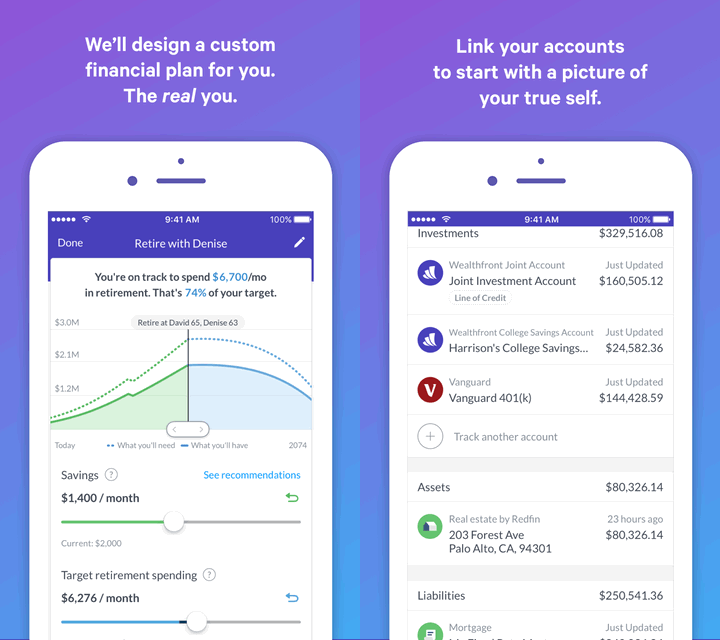
Wealthfront is one of the largest independent digital advisory firms (i.e. not tied to a specific brand of funds like Vanguard or Schwab). With a younger target audience (20s to 40s), their offering is for folks that are comfortable having nearly all interactions via smartphone or website. They frequently announce new features and improvements, so I will work to keep this feature list updated.
Diversified portfolio of high-quality, low-cost ETFs. Their portfolios are a diversified mix of several asset classes including: US Total, US Dividend, International Developed, US Corporate Bonds, Muni Bonds, Emerging Market Bonds, REITs, and Natural Resources. For the most part, low-cost Vanguard and iShares ETFs are used. You could argue the finer points of a specific portfolio, but overall it is backed by academic research (Chief Investment Officer is Burton Malkiel).
Direct indexing. If your account is over $100,000, Wealthfront will buy all the stocks in the S&P 500 individually and commission-free. ETF expense ratios are pretty low now, so this is mostly used as an opportunity for more tax-loss harvesting. No other robo-advisor offers this feature. Here is whitepaper that details their position. As long as you meet the $100k minimum, there is no additional cost fee above the standard management fee.
Smart-beta. If your account is over $500,000, Wealthfront created Advanced Indexing as their answer to “smart-beta” investing. It works within its Direct Indexing feature in order to improve tax efficiency. As long as you meet the $500k minimum, there is no additional cost fee above the standard management fee.

Financial planning software with outside account integration. Path is Wealthfront’s new financial planning software, launched in February 2017. This service links your external accounts from other banks, brokerages, and 401k plans (similar to Mint and Personal Capital) in order to see your entire picture without having to manually input your balances and transactions. How much do I have invested elsewhere? How much am I spending? How much am I saving? How much can I spend in retirement?
Path can forecast your saving rate using the last 12 months of transactions. Investment returns are estimated using Monte Carlo analysis. It also accounts for your household income, birthdate, and chosen retirement age to estimate how Social Security will affect your retirement income needs. You can change up the variables and see how it will affect your retirement outlook.
College Savings Planning. You can select a college for real-time expense projections, get a customized estimate of financial aid, and receive a personalized college savings plan to cover the difference. This works with or without their own Wealthfront 529 College Savings account.
Account types. Wealthfront now supports taxable joint accounts, trust accounts, 401k rollovers, Traditional IRAs, Roth IRAs, and SEP IRAs. They also offer a 529 College Savings account.
Tax-sensitive account transfers. This is good news if you already have an existing portfolio with unrealized capital gains. Other robo-advisors may have a “switch calculator” to help you decide whether to move over or not, but Wealthfront will actually accept your existing investments and manage it for you alongside your new investments.
If you want to switch advisors or move your brokerage holdings into a diversified portfolio, you typically have to sell all your holdings and move in cash. This means you will more than likely have a large tax bill. Instead of selling your holdings, Wealthfront will directly transfer them into a diversified portfolio tax efficiently, saving you that tax bill.
Tax-efficent asset location. They will place different asset classes in your taxable accounts vs. tax-deferred accounts (IRAs, 401ks) for a higher after-tax return. However, they do not treat them holistically (i.e. putting all one of one asset in IRA and none in taxable). Non-Wealthfront accounts are also not taken into consideration.
Use dividends and new contributions to rebalance. They will use your dividends and new contributions to rebalance your asset classes in order to minimize sells and thus minimize capital gains.
Concentrated holding of a single stock? Wealthfront caters to the tech start-up crowd with a unique Selling Plan service for people with much of their net worth tied up in a single stock. They’ll help you sell your positions gradually in a tax-efficent manner. Currently available to shareholders of: Alphabet, Amazon, Apple, Arista Networks, Box, Facebook, Pure Storage, Square, Twilio, Twitter, Yelp, Zillow.
Daily tax-loss harvesting. Wealthfront software monitors your holdings daily and attempts to find opportunities to harvest tax losses by switching between “similar but not substantially identical” ETFs. If you can delay paying taxes and reinvest them, this can result in a greater after-tax return. The exact “tax alpha” of this practice depends on multiple factors like portfolio size and tax brackets. You can read the Wealthfront side of things in this whitepaper and Schwab comparison. Here is an outside viewpoint arguing for more conservative estimates.
My opinion is that there is long-term value in tax-loss harvesting and especially daily monitoring to capture more losses. However, I also think it’s wise to use a conservative assumption as to the size of that value. (DIY investors can perform their own tax-loss harvesting as well on a less-frequent basis. I do it myself, but it’s rather tedious and I’m definitely not doing it more often than once a year. I would gladly leave it to the bots if it was cheap enough.)
Portfolio Line of Credit. If your taxable balance is over $100,000, Wealthfront will automatically give you a line of credit of up to 30% of your balance. There is no application, no fees, low interest rates, and you can get cash in as little as 1 business day. The rates are advertised to be even lower than a Home Equity Line of Credit (HELOC). Keep your loan balances modest though, as this is a margin lending product and they may force you to sell your investments if your outstanding balance exceeds your available margin.
Fee schedule. The fee schedule for Wealthfront is simple – Everyone gets charged a flat advisory fee of 0.25% of assets annually (first $10,000 waived). All of the features listed above are included. As your asset size increases, you get access to some additional features like Direct Indexing and Advanced Indexing (Smart-Beta).
Bottom line. Wealthfront is an independent digital advisory firm with over $7 billion in assets. Independent which means they aren’t tied to any specific brand of funds like Vanguard, Fidelity, or Schwab. Their main differentiators from the other independent firms (see my Betterment review) are (1) Direct Indexing and Advanced (Smart-Beta) Indexing portfolio management for optimal tax-efficiency and (2) customized assistance with transferring in your existing investments (including company stock) and then selling them tax-efficiently. Other notable features include: Financial planning software that incorporates external accounts, tax-loss harvesting, 529 college saving plan and guidance software, and a portfolio line-of-credit.
Special offer. Open a Wealthfront account via my invite link and get your first $15,000 managed for free, forever. This is an additional $5,000 above the standard $10,000 balance waiver. You can then invite your own friends for more savings (your friend gets $15k managed free as well, and you get another $5k managed for free.)
 The Best Credit Card Bonus Offers – 2025
The Best Credit Card Bonus Offers – 2025 Big List of Free Stocks from Brokerage Apps
Big List of Free Stocks from Brokerage Apps Best Interest Rates on Cash - 2025
Best Interest Rates on Cash - 2025 Free Credit Scores x 3 + Free Credit Monitoring
Free Credit Scores x 3 + Free Credit Monitoring Best No Fee 0% APR Balance Transfer Offers
Best No Fee 0% APR Balance Transfer Offers Little-Known Cellular Data Plans That Can Save Big Money
Little-Known Cellular Data Plans That Can Save Big Money How To Haggle Your Cable or Direct TV Bill
How To Haggle Your Cable or Direct TV Bill Big List of Free Consumer Data Reports (Credit, Rent, Work)
Big List of Free Consumer Data Reports (Credit, Rent, Work)
From the white paper:
“In some cases, we may purchase more of an existing holding. For example, if Coca-Cola misses an earnings estimate and drops precipitously in value we would sell Coke and use the proceeds to buy more PepsiCo to maintain the correlation with VTI in the absence of Coca-Cola.”
This seems more like trading.
That quote is regards to Direct Indexing, an optional feature mentioned above where they buy the underlying stocks in an index as opposed to just holding an index ETF like VTI. As noted, the purpose is to generate tax losses, which ETFs are not allowed to pass through. Buying Pepsi instead of Coca-Cola to generate a tax loss (and then switching back to KO later) can lead to a different return (tracking error) and thus vary from the benchmark index. Which will lead to the best after-tax return in the end? The backtested results look okay, but that is no guarantee of actual results.
This feature is probably one of the more marginal features of Wealthfront. You could simply decline it, as US stocks are only a portion of your portfolio anyway. ETF-based tax-loss harvesting will produce a more significant effect.
Jonathan,
So, what’s your take on this 0.25% fee: in your best estimate, would their automatic TLH and rebalancing would truly beat it?
Let’s take, for instance, 100k portfolio and marginal tax rate of, say, 28%?
Well… that’s pretty much a whole separate post right there. The short version: Tax-deferred accounts won’t benefit. $100,000 of taxable would probably be the sweet spot. If they can harvest 3% losses from the portfolio, that’s the full $3,000 of tax-losses that can offset ordinary income annually. If they harvest more, they can spread out to future years. At a 28% marginal tax rate + $100k taxable portfolio, then yes I think the chances are good that the benefit ends up being above 0.25% per year. Now, if you portfolio was $1,000,000 instead, the % benefit would be lower.
Automatic rebalancing, I believe there is probably a long-term benefit as well. How much more than if you did it yourself annually? Harder to say.
Don’t you think the TLH benefits are going to be very much frontloaded? A lot in the first year, but not so much later on, unless there’s an epic collapse, or you are contributing a significant new amount going forward.
Are there any reviews/summaries that I’ve missed (I have this blog in Feedly, so it does not seem like it) regarding third party portfolio managers, i.e. those with whom you don’t actually have your money?
I am using Market Riders with my Keogh accounts, which have to remain with TD Ameritrade per my company’s plan parameters (not that I’m complaining – I love it). Market Riders charges a fair fee and gets me where I need to go, but their synching is awful and it doesn’t play so well with separate Roth/traditional accounts (you have to treat it as one), so I’ve been curious about whether there is anything else out there. Last I looked, there was not.
I wrote about Market Riders a long time ago when they first came out back in 2012. It didn’t seem like they got a great deal of traction, so I haven’t really kept up with them. It seemed like people were either DIY or DIFM (Do It For Me) and MarketRiders was in the middle.
https://www.mymoneyblog.com/marketriders-portfolio-manager-review-first-look-asset-allocation.html
What other third-party portfolio managers are on your radar?
Jonathan,
It is now down to $5,000 managed for free with a referral link ($0 without).